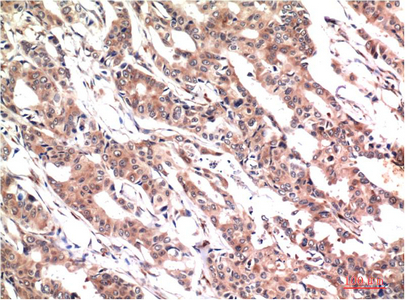Stat3 Polyclonal Antibody
- Catalog No.:YT4443
- Applications:IF;WB;IHC;ELISA
- Reactivity:Human;Mouse;Rat
- Target:
- Stat3
- Fields:
- >>EGFR tyrosine kinase inhibitor resistance;>>Chemokine signaling pathway;>>HIF-1 signaling pathway;>>FoxO signaling pathway;>>Necroptosis;>>Signaling pathways regulating pluripotency of stem cells;>>JAK-STAT signaling pathway;>>Th17 cell differentiation;>>Prolactin signaling pathway;>>Adipocytokine signaling pathway;>>Insulin resistance;>>AGE-RAGE signaling pathway in diabetic complications;>>Growth hormone synthesis, secretion and action;>>Toxoplasmosis;>>Hepatitis C;>>Hepatitis B;>>Measles;>>Human cytomegalovirus infection;>>Kaposi sarcoma-associated herpesvirus infection;>>Epstein-Barr virus infection;>>Coronavirus disease - COVID-19;>>Pathways in cancer;>>Viral carcinogenesis;>>Proteoglycans in cancer;>>MicroRNAs in cancer;>>Chemical carcinogenesis - receptor activation;>>Pancreatic cancer;>>Acute myeloid leukemia;>>Non-small cell lung cancer;>>PD-L1 expression and PD-1 checkpoint pathway in cancer;>>Inflammatory bowel disease;>>Lipid and atherosclerosis
- Gene Name:
- STAT3
- Protein Name:
- Signal transducer and activator of transcription 3
- Human Gene Id:
- 6774
- Human Swiss Prot No:
- P40763
- Mouse Gene Id:
- 20848
- Mouse Swiss Prot No:
- P42227
- Rat Gene Id:
- 25125
- Rat Swiss Prot No:
- P52631
- Immunogen:
- The antiserum was produced against synthesized peptide derived from human STAT3. AA range:672-721
- Specificity:
- Stat3 Polyclonal Antibody detects endogenous levels of Stat3 protein.
- Formulation:
- Liquid in PBS containing 50% glycerol, 0.5% BSA and 0.02% sodium azide.
- Source:
- Polyclonal, Rabbit,IgG
- Dilution:
- IF 1:50-200 WB 1:500 - 1:2000. IHC 1:100 - 1:300. ELISA: 1:5000. Not yet tested in other applications.
- Purification:
- The antibody was affinity-purified from rabbit antiserum by affinity-chromatography using epitope-specific immunogen.
- Concentration:
- 1 mg/ml
- Storage Stability:
- -15°C to -25°C/1 year(Do not lower than -25°C)
- Other Name:
- STAT3;APRF;Signal transducer and activator of transcription 3;Acute-phase response factor
- Observed Band(KD):
- 88kD
- Background:
- The protein encoded by this gene is a member of the STAT protein family. In response to cytokines and growth factors, STAT family members are phosphorylated by the receptor associated kinases, and then form homo- or heterodimers that translocate to the cell nucleus where they act as transcription activators. This protein is activated through phosphorylation in response to various cytokines and growth factors including IFNs, EGF, IL5, IL6, HGF, LIF and BMP2. This protein mediates the expression of a variety of genes in response to cell stimuli, and thus plays a key role in many cellular processes such as cell growth and apoptosis. The small GTPase Rac1 has been shown to bind and regulate the activity of this protein. PIAS3 protein is a specific inhibitor of this protein. Mutations in this gene are associated with infantile-onset multisystem autoimmune disease and hyper
- Function:
- disease:Defects in STAT3 are the cause of hyperimmunoglobulin E recurrent infection syndrome autosomal dominant (AD-HIES) [MIM:147060]; also known as hyper-IgE syndrome or Job syndrome. AD-HIES is a rare disorder of immunity and connective tissue characterized by immunodeficiency, chronic eczema, recurrent Staphylococcal infections, increased serum IgE, eosinophilia, distinctive coarse facial appearance, abnormal dentition, hyperextensibility of the joints, and bone fractures.,function:Transcription factor that binds to the interleukin-6 (IL-6)-responsive elements identified in the promoters of various acute-phase protein genes. Activated by IL31 through IL31RA.,miscellaneous:Involved in the gp130-mediated signaling pathway.,online information:STAT3 entry,online information:STAT3 mutation db,PTM:Tyrosine phosphorylated in response to IL-6, IL-11, CNTF, LIF, CSF-1, EGF, PDGF, IFN-alpha an
- Subcellular Location:
- Cytoplasm . Nucleus . Shuttles between the nucleus and the cytoplasm. Translocated into the nucleus upon tyrosine phosphorylation and dimerization, in response to signaling by activated FGFR1, FGFR2, FGFR3 or FGFR4. Constitutive nuclear presence is independent of tyrosine phosphorylation. Predominantly present in the cytoplasm without stimuli. Upon leukemia inhibitory factor (LIF) stimulation, accumulates in the nucleus. The complex composed of BART and ARL2 plays an important role in the nuclear translocation and retention of STAT3. Identified in a complex with LYN and PAG1.
- Expression:
- Heart, brain, placenta, lung, liver, skeletal muscle, kidney and pancreas. Expressed in naive CD4(+) T cells as well as T-helper Th17, Th1 and Th2 cells (PubMed:31899195).
Downregulation of RIPK4 Expression Inhibits Epithelial-Mesenchymal Transition in Ovarian Cancer through IL-6. Journal of Immunology Research J Immunol Res. 2021;2021:8875450 WB Human 1 : 1000 SKOV3 cell
CXCL5, the upregulated chemokine in patients with uterine cervix cancer, in vivo and in vitro contributes to oncogenic potential of Hela uterine cervix cancer cells. BIOMEDICINE & PHARMACOTHERAPY Biomed Pharmacother. 2018 Nov;107:1496 WB Human,Mouse 1:1000 Hela cell-xenografts Hela cell
Inflammatory factor TNF-α promotes the growth of breast cancer via the positive feedback loop of TNFR1/NF-κB (and/or p38)/p-STAT3/HBXIP/TNFR1. Oncotarget Oncotarget. 2017 Aug 29; 8(35): 58338–58352 WB Human MDA-MB-468 cell
Oncoprotein HBXIP enhances HOXB13 acetylation and co-activates HOXB13 to confer tamoxifen resistance in breast cancer. Journal of Hematology & Oncology 2018 Feb 23 WB Human BT474 cell
HIF‐1α facilitates osteocyte‐mediated osteoclastogenesis by activating JAK2/STAT3 pathway in vitro. JOURNAL OF CELLULAR PHYSIOLOGY 2019 Apr 29 WB Mouse 1:500 MLO-Y4 cell
Suppressed androgen receptor expression promotes M2 macrophage reprogramming through the STAT3/SOCS3 pathway. EXCLI Journal Excli J. 2019; 18: 21–29 WB Mouse 1:1000 Raw264.7 cell
Integrative proteomics and immunochemistry analysis of the factors in the necrosis and repair in acetaminophen‐induced acute liver injury in mice. JOURNAL OF CELLULAR PHYSIOLOGY J Cell Physiol. 2019 May;234(5):6561-6581 WB Mouse 1:100 liver
N′-[(3-[benzyloxy]benzylidene]-3,4,5-trihydroxybenzohydrazide (1) protects mice against colitis induced by dextran sulfate sodium through inhibiting NFκB/IL-6/STAT3 pathway. BIOCHEMICAL AND BIOPHYSICAL RESEARCH COMMUNICATIONS Biochem Bioph Res Co. 2016 Aug;477:290 WB Mouse 1:1000 colon
Resveratrol enhanced chemosensitivity by reversing macrophage polarization in breast cancer. Clinical & Translational Oncology Clin Transl Oncol. 2021 Dec;:1-10 WB,IHC Human 1:1000 MDA-MB-231(MB231)cell-xenograft MDA-MB-231(MB231)cell
Gene silencing of USP1 by lentivirus effectively inhibits proliferation and invasion of human osteosarcoma cells. INTERNATIONAL JOURNAL OF ONCOLOGY 2016 Dec 01 WB Human U2OS cell
-Induced Injury in Induced Pluripotent Stem Cell-Derived Neural Stem Cells. NEUROCHEMICAL RESEARCH Neurochem Res. 2015 Jun;40(6):1133-1143 WB Mouse 1:1000 iPSC-derived NSCs
Cancer Stem Cells are Regulated by STAT3 Signalling in Wilms Tumour. Journal of Cancer J Cancer. 2018; 9(8): 1486–1499 WB Human,Mouse 1:1000 G401-Xenograft G401 cell
Shu, Tao, et al. "Protective effects and mechanisms of salvianolic acid B against H2O2-Induced injury in induced pluripotent stem cell-derived neural stem cells." Neurochemical research 40.6 (2015): 1133-1143.
N′-[(3-[benzyloxy] benzylidene]-3, 4, 5-trihydroxybenzohydrazide (1) protects mice against colitis induced by dextran sulfate sodium through inhibiting NFκB/IL-6/STAT3 pathway." Biochemical and biophysical research communications 477.2 (2016): 290-296.
Flavonoid Group of Smilax glabra Roxb. Regulates the Anti-Tumor Immune Response Through the STAT3/HIF-1 Signaling Pathway Frontiers in Pharmacology Qiyang Shou WB Mouse
miRNA-331-3p Affects the Proliferation, Metastasis, and Invasion of Osteosarcoma through SOCS1/JAK2/STAT3 Journal of Oncology Bing Wu WB Mouse
Nanocarrier of Pin1 inhibitor based on supercritical fluid technology inhibits cancer metastasis by blocking multiple signaling pathways Regenerative Biomaterials Dayun Yang WB Human,Mouse lung tissues HuH7 cell,HepG2 cell
Progranulin promoted the proliferation, metastasis, and suppressed apoptosis via JAK2-STAT3/4 signaling pathway in papillary thyroid carcinoma. Cancer Cell International Zhen Liu WB Human 1:800 BCPAP cell,TPC1 cell
- June 19-2018
- WESTERN IMMUNOBLOTTING PROTOCOL
- June 19-2018
- IMMUNOHISTOCHEMISTRY-PARAFFIN PROTOCOL
- June 19-2018
- IMMUNOFLUORESCENCE PROTOCOL
- September 08-2020
- FLOW-CYTOMEYRT-PROTOCOL
- May 20-2022
- Cell-Based ELISA│解您多样本WB检测之困扰
- July 13-2018
- CELL-BASED-ELISA-PROTOCOL-FOR-ACETYL-PROTEIN
- July 13-2018
- CELL-BASED-ELISA-PROTOCOL-FOR-PHOSPHO-PROTEIN
- July 13-2018
- Antibody-FAQs
- Products Images
.jpg)
- Jiao, Z., Ma, Y., Zhang, Q. et al. The adipose-derived mesenchymal stem cell secretome promotes hepatic regeneration in miniature pigs after liver ischaemia-reperfusion combined with partial resection. Stem Cell Res Ther 12, 218 (2021).
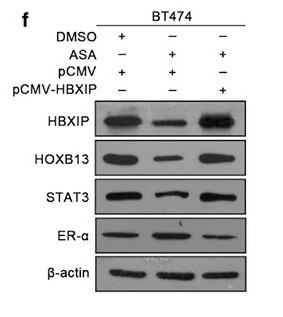
- Liu, Bowen, et al. "Oncoprotein HBXIP enhances HOXB13 acetylation and co-activates HOXB13 to confer tamoxifen resistance in breast cancer." Journal of hematology & oncology 11.1 (2018): 26.
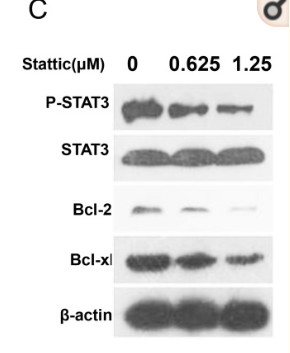
- Liu, Yanmei, et al. "Cancer Stem Cells are Regulated by STAT3 Signalling in Wilms Tumour." Journal of Cancer 9.8 (2018): 1486.
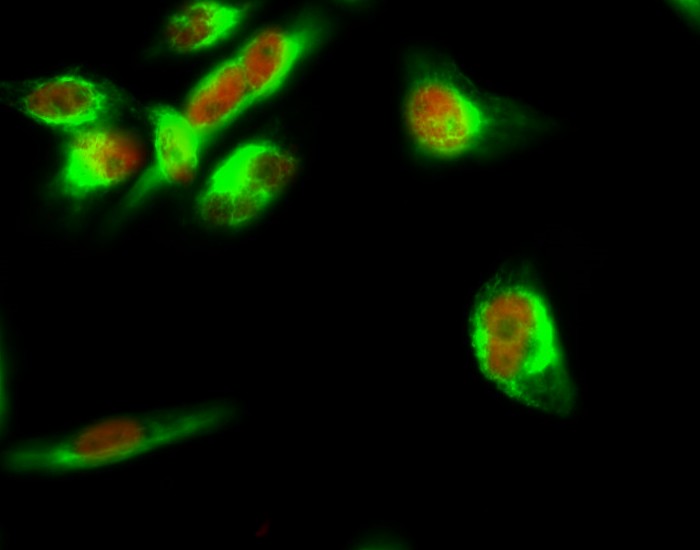
- Immunofluorescence analysis of Hela cell. 1,Stat3 Polyclonal Antibody(red) was diluted at 1:200(4° overnight). β-tubulin Monoclonal Antibody(M7)(green) was diluted at 1:200(4° overnight). 2, Goat Anti Rabbit Alexa Fluor 594 Catalog:RS3611 was diluted at 1:1000(room temperature, 50min). Goat Anti Mouse Alexa Fluor 488 Catalog:RS3208 was diluted at 1:1000(room temperature, 50min).
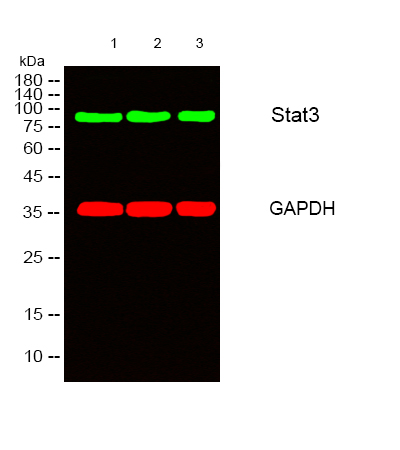
- Western blot analysis of lysates from 1) HepG2-UV, 2) K562, 3) AD293 ,4) PC-3 cells, (Green) primary antibody was diluted at 1:1000, 4°over night, secondary antibody(cat:RS23920)was diluted at 1:10000, 37° 1hour. (Red) GAPDH Monoclonal Antibody(2B8) (cat:YM3029) antibody was diluted at 1:5000 as loading control, 4° over night,secondary antibody(cat:RS23710)was diluted at 1:10000, 37° 1hour.
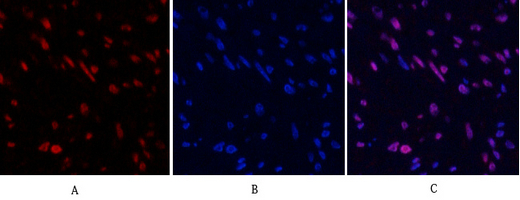
- Immunofluorescence analysis of human-uterus tissue. 1,Stat3 Polyclonal Antibody(red) was diluted at 1:200(4°C,overnight). 2, Cy3 labled Secondary antibody was diluted at 1:300(room temperature, 50min).3, Picture B: DAPI(blue) 10min. Picture A:Target. Picture B: DAPI. Picture C: merge of A+B
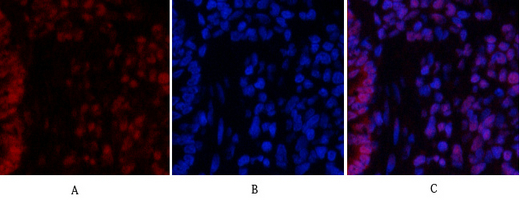
- Immunofluorescence analysis of rat-lung tissue. 1,Stat3 Polyclonal Antibody(red) was diluted at 1:200(4°C,overnight). 2, Cy3 labled Secondary antibody was diluted at 1:300(room temperature, 50min).3, Picture B: DAPI(blue) 10min. Picture A:Target. Picture B: DAPI. Picture C: merge of A+B

- Immunohistochemical analysis of paraffin-embedded Human-uterus tissue. 1,Stat3 Polyclonal Antibody was diluted at 1:200(4°C,overnight). 2, Sodium citrate pH 6.0 was used for antibody retrieval(>98°C,20min). 3,Secondary antibody was diluted at 1:200(room tempeRature, 30min). Negative control was used by secondary antibody only.
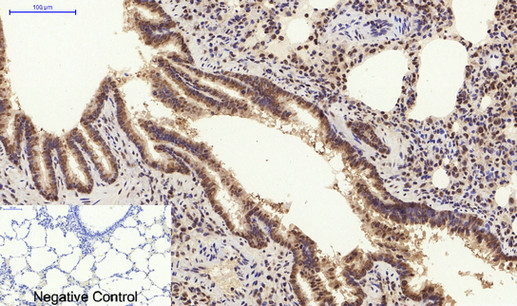
- Immunohistochemical analysis of paraffin-embedded Rat-lung tissue. 1,Stat3 Polyclonal Antibody was diluted at 1:200(4°C,overnight). 2, Sodium citrate pH 6.0 was used for antibody retrieval(>98°C,20min). 3,Secondary antibody was diluted at 1:200(room tempeRature, 30min). Negative control was used by secondary antibody only.
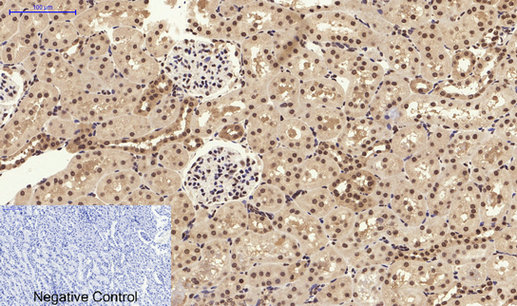
- Immunohistochemical analysis of paraffin-embedded Rat-kidney tissue. 1,Stat3 Polyclonal Antibody was diluted at 1:200(4°C,overnight). 2, Sodium citrate pH 6.0 was used for antibody retrieval(>98°C,20min). 3,Secondary antibody was diluted at 1:200(room tempeRature, 30min). Negative control was used by secondary antibody only.
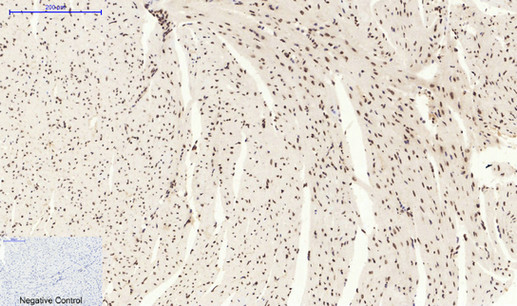
- Immunohistochemical analysis of paraffin-embedded Mouse-heart tissue. 1,Stat3 Polyclonal Antibody was diluted at 1:200(4°C,overnight). 2, Sodium citrate pH 6.0 was used for antibody retrieval(>98°C,20min). 3,Secondary antibody was diluted at 1:200(room tempeRature, 30min). Negative control was used by secondary antibody only.
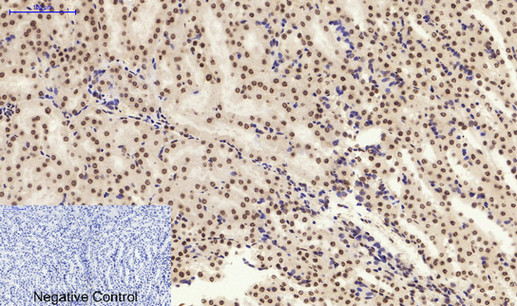
- Immunohistochemical analysis of paraffin-embedded Mouse-kidney tissue. 1,Stat3 Polyclonal Antibody was diluted at 1:200(4°C,overnight). 2, Sodium citrate pH 6.0 was used for antibody retrieval(>98°C,20min). 3,Secondary antibody was diluted at 1:200(room tempeRature, 30min). Negative control was used by secondary antibody only.
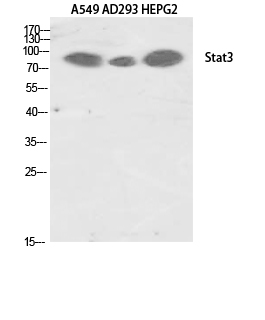
- Western Blot analysis of A549 AD293 HEPG2 using Stat3 Polyclonal Antibody. Antibody was diluted at 1:2000
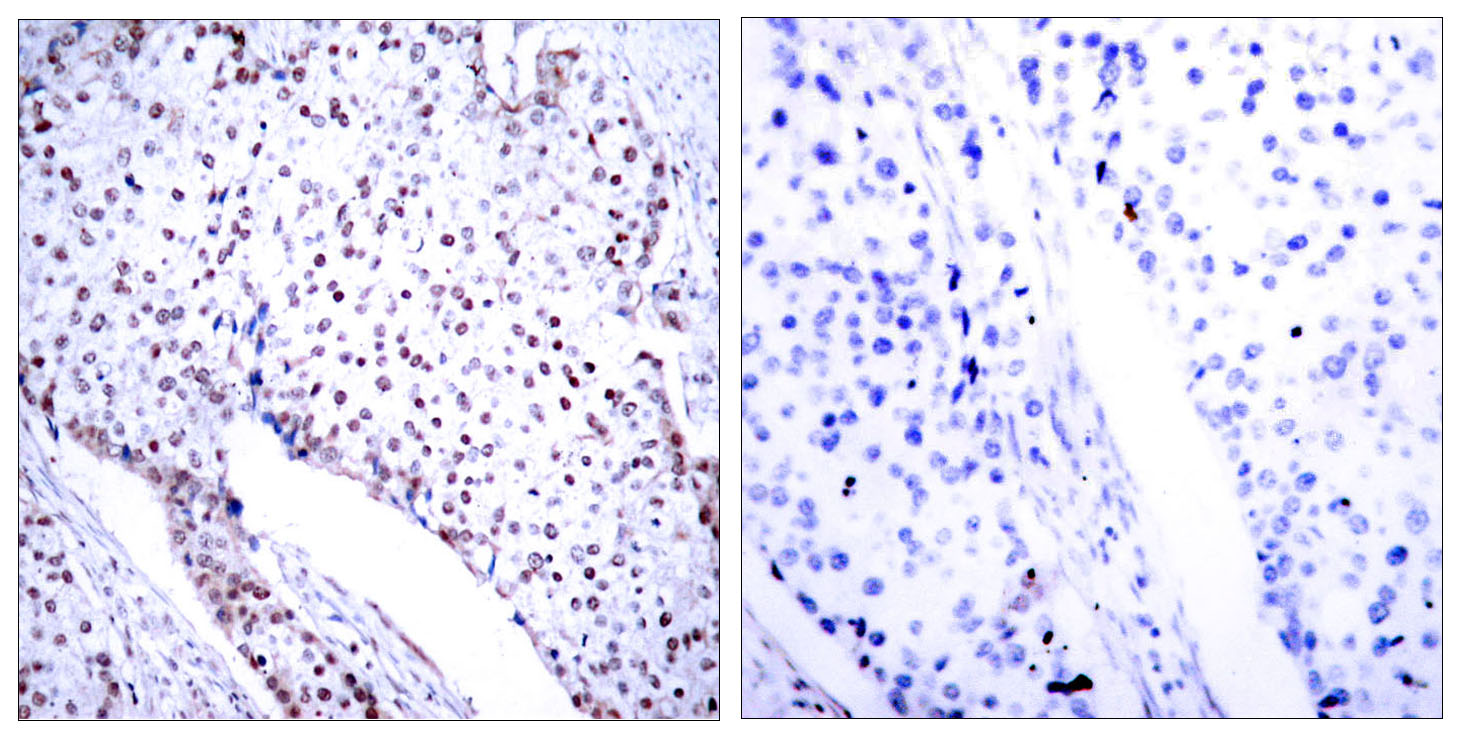
- Immunohistochemistry analysis of paraffin-embedded human breast carcinoma tissue, using STAT3 Antibody. The picture on the right is blocked with the synthesized peptide.

